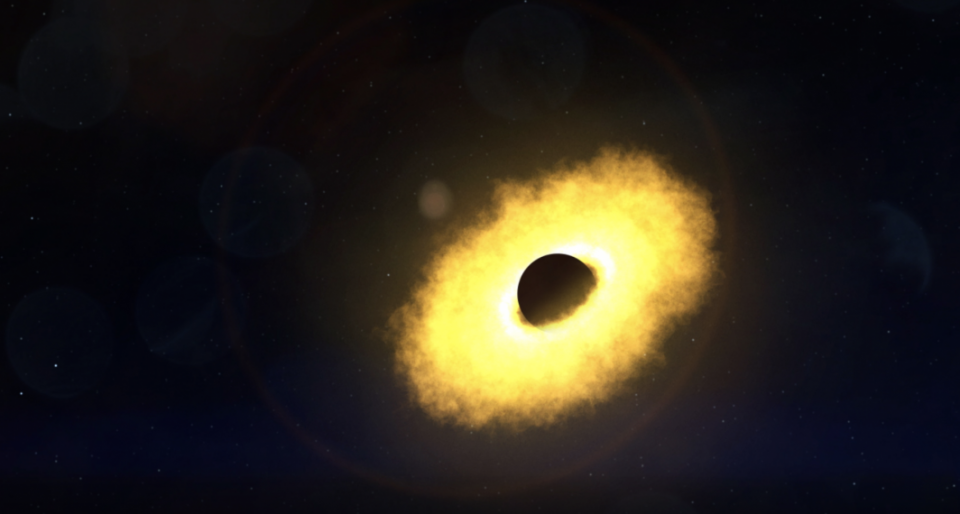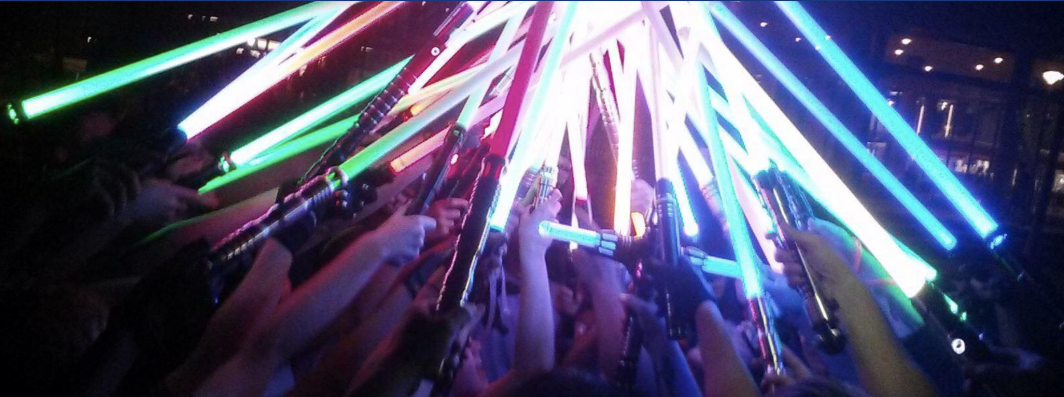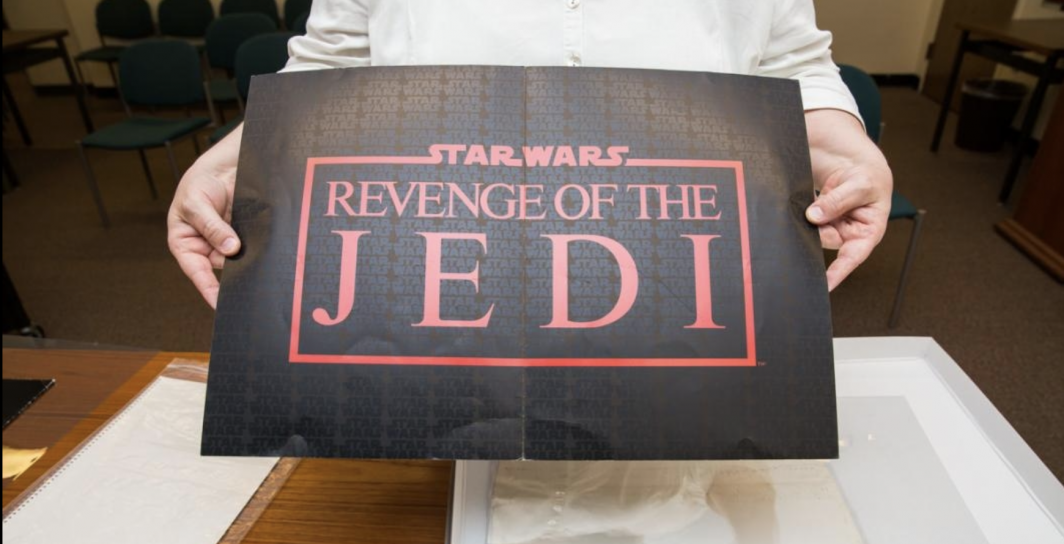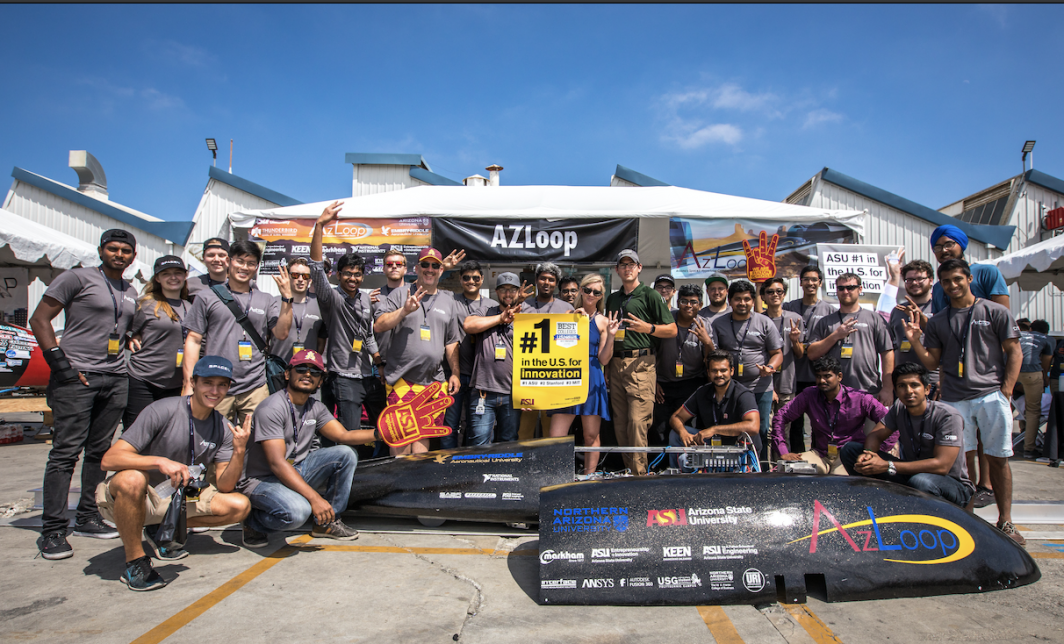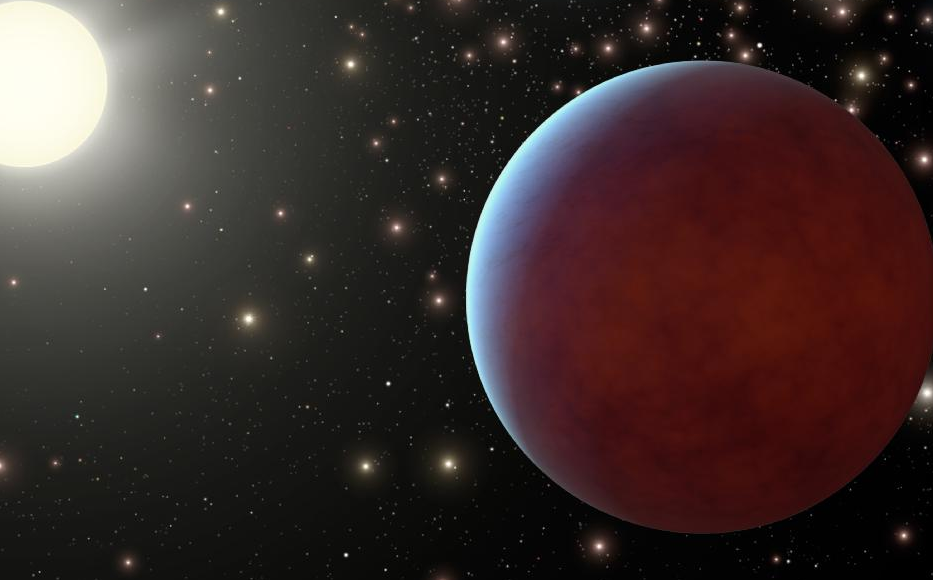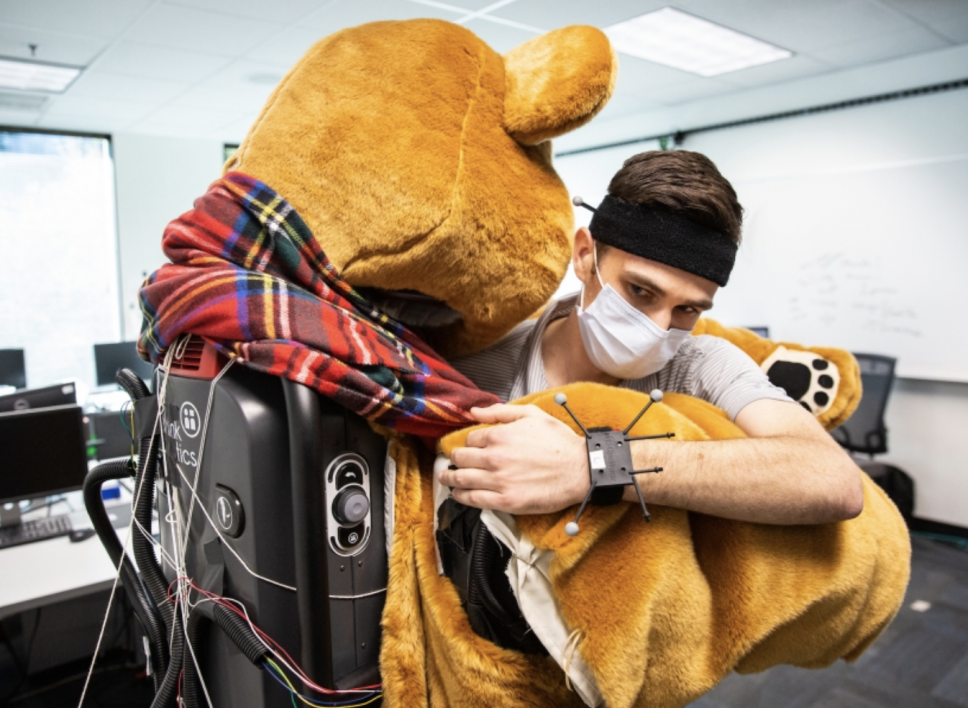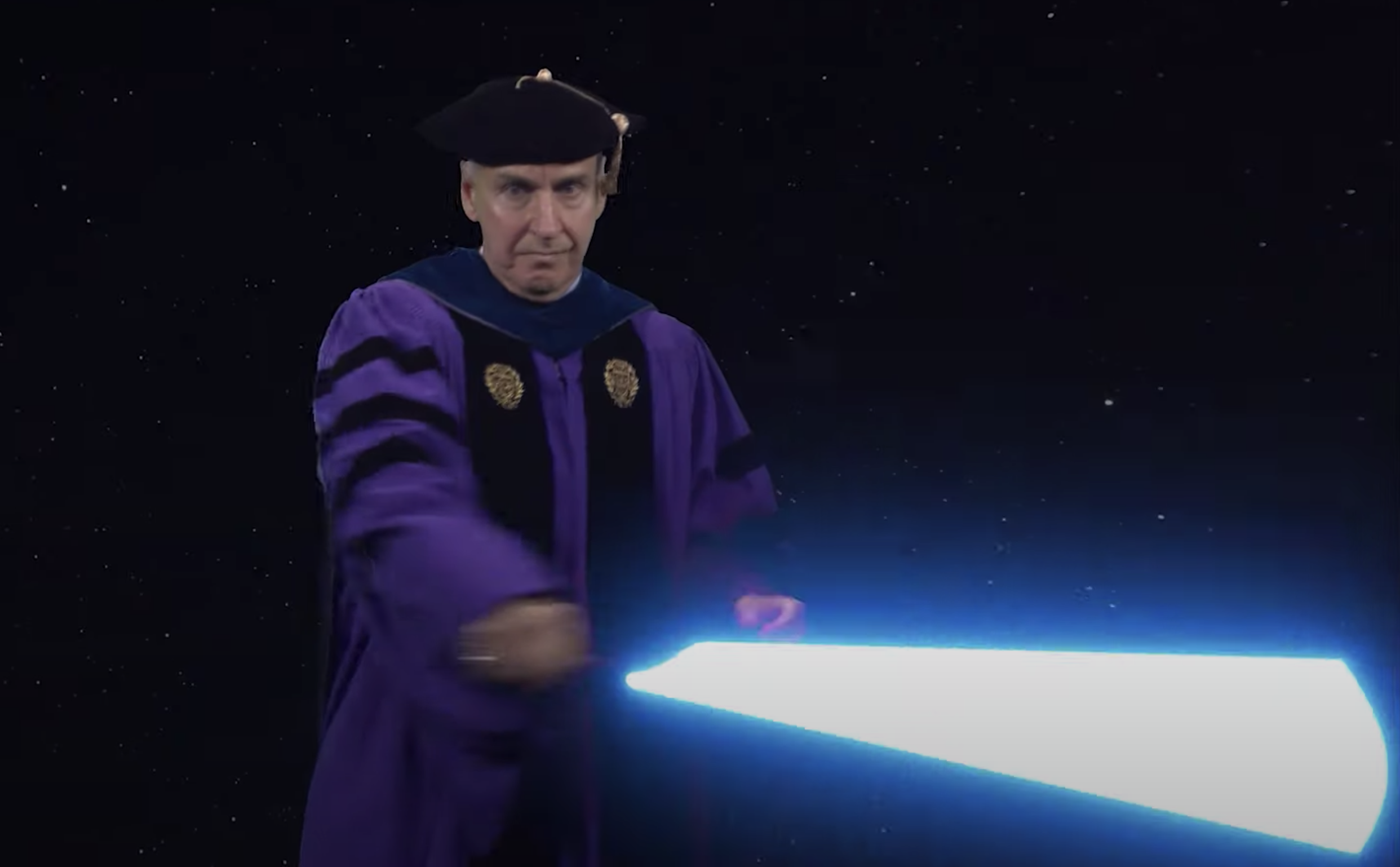"Dreams are extremely important. You can't do it unless you imagine it." — George Lucas
Fifty years ago, a young, visionary director founded his original "rebel base" — his filmmaking company.
Over the course of the next several years at Lucasfilm, George Lucas wrote a sci-fi trilogy script inspired by the "heroes journey" and mythical archetypes of Joseph Campbell. He took the world by storm with the release of "Star Wars" in 1977. His company retained fierce independence — and most importantly, the copyright, sequel and prescient merchandising rights for the franchise.
The worldwide appeal of Star Wars continues to resonate today.
And so, we celebrate the inner nerd in each of us by commemorating the annual celebration of Star Wars Day and this year's 50th anniversary of the founding of Lucasfilm.
Fan of the original trilogy? Or maybe the prequels? (We see you, secret Jar Jar fans.) Or the new generation of heroes? Whether you're attracted to the light or the dark side, bring your popcorn, candy and favorite soft drink, and pull up a seat for a gallery of fun and action-packed Star Wars-themed ASU inspirations.
May the Fourth be with you!
A long time ago in galaxy, far, far away …
Nature has its own version of the Death Star — black holes. And ASU theoretical physicist Cecilia Lunardini is fascinated by them.
Some 700 million years ago, subatomic particles called neutrinos were hurled at nearly the speed of light toward Earth as a result of a peculiar cosmic encounter: A star wandered too close to a supermassive black hole and was ripped apart by the black hole’s colossal gravity.
Part of the star’s debris eventually fell back onto the black hole, causing a luminous flare, which scientists observed in the night sky.
Scientists like Lundardini think that this phenomenon, called a tidal disruption event (TDE), could accelerate particles to nearly the speed of light. Talk about making the jump to hyperspace. Those particles then collide with light or other particles to generate high-energy neutrinos.
When the neutrinos began their journey some 700 million years ago, the first animals developed on Earth. That is the travel time the particle needed to get from the far-away, unnamed galaxy (catalogued as 2MASX J20570298+1412165) in the constellation Delphinus (the dolphin) to detect on Earth today.
Eventually, stellar debris settles into an accretion disk around the black hole, as illustrated here. Gravitational and frictional forces heat the material, producing visible ultraviolet and X-ray emissions. Photo courtesy NASA
An elegant weapon for a more civilized age
You don't always have to let the Wookiee win.
Meet the ASU Lightsaber club (pictured at top), a fun-filled, action-packed ASU-based organization open to all who are interested in learning new skills focused on combat and gaming. If you’d like to reclaim that sci-fi magic with a fun and open community on campus, AZ Saber is the right group for you. Monica Conner of the College of Integrative Sciences and Arts is the staff adviser for AZ Saber and one of the club’s founding members.
As they say on their Facebook page, the club is "for a group of nerds who like to hit each other with Lightsabers!" You can find them on an ASU field near you.
All skill levels are welcome up for those interested in entering ASU's version of a Jedi academy.
Revenge of the Jedi?
A Jedi focused on revenge? As master Yoda once warned, "Fear is the path to the dark side. Fear leads to anger. Anger leads to hate." It's no wonder Lucas had a last-minute change of heart and changed the title to "Return of the Jedi," much to to the chagrin of merchandisers who already jumped the gun. (Like Han, who definitely shot first.)
But did you also know ASU has its own curated Star Wars collection for anyone to see this marketing mea culpa up close? The Nicholas A. Salerno Star Wars Collection houses publicity materials and merchandising products for the Star Wars film series from 1976–2005. The bulk of the materials focuses on the original trilogy: "Star Wars" (1977), "The Empire Strikes Back" (1980) and "Return of the Jedi" (1983).
In this collection are press kits, including a rare "Revenge of the Jedi" pre-release press kit and two fold-out posters for the film, as well as other promotional materials: journal, magazine and newspaper articles; still photographs; vinyl phonograph and magnetic tape audio recordings; and digital, magnetic tape and film moving images. Rounding out the collection are posters, fabric textiles and co-branded and licensed merchandising products, including 130 action figures, a model of the Millennium Falcon, and the Dagobah and Ewok Village playsets.
Learn more: "Star Wars" collection transports scholars to a galaxy far, far away
A volunteer at Hayden Library shares a press packet for "Return of the Jedi" with its original title, "Revenge of the Jedi." Photo by Deanna Dent/ASU News
Now, THIS is podracing
Turns out Lucas' visionary Star Wars mode of travel may have inspired the next generation of entrepreneurs. Elon Musk, for example, envisioned a new form of ground transport called the Hyperloop, where passengers travel at over 700 miles an hour in a floating pod that races along inside giant low-pressure tubes, either above or below ground.
And Musk extended development to university competitions. The Hyperloop Pod Competition was an annual competition sponsored by SpaceX held from 2015–2019 in which a number of student teams designed and built a subscale prototype transport vehicle in order to demonstrate technical feasibility of various aspects of the Hyperloop concept.
In 2017, AZLoop — a team made up of students from Arizona State University, Embry-Riddle Aeronautical University and Northern Arizona University — finished in the top eight out of 35 teams at the second Hyperloop competition sponsored by SpaceX. Being on the SpaceX campus, with rockets and pods on display and Teslas parked everywhere, planes roaring overhead out of the airport, was engineering heaven for the ASU engineers.
The winner was the German WARR team, with a top speed of 201 miles per hour.
"She may not look like much, but she's got it where it counts, kid."
Watch the AZLoop team visit SpaceX.
AZLoop team members pose with the pod for a group photo during the final round of the SpaceX competition in California in 2019. Photo by Charlie Leight/ASU News
The forces with us
Does "the force" really surround us and penetrate us? Bind the galaxy together, like in the Star Wars universe? And how can we mere apprentices begin to grasp the exciting new questions, discoveries and intense debates that are shaping cosmology and modern physics?
ASU's version of a Jedi master is Frank Wilczek.
Want to learn the the basics of the universe and 21st-century physics in a mere four minutes? Or, for young padawans, perhaps the texts? In his latest book, "Fundamentals: Ten Keys to Reality," Wilczek, a theoretical physicist, Nobel Prize laureate and professor of physics at ASU, breaks it all down for us — with no math at all! In this excerpt, he describes the simple building blocks and fundamental forces that govern the universe and are fueling today’s discoveries.
That's no moon …
That's an exoplanet!
Scientists at ASU and the Southwest Research Institute (SwRI) have identified stellar phosphorus as a probable marker in narrowing the search for life in the cosmos and have developed techniques to identify stars likely to host exoplanets, based on the composition of stars known to have planets.
Scientists can measure the abundance of elements in a star spectroscopically, studying how light interacts with the elements in a star’s upper layers. Using these data, scientists can infer what a star’s orbiting planets are made of, using stellar composition as a proxy for the planet composition.
“The relative proportions of other elements produced and spread by supernova explosions have significant variations between stars,” said astrophysicist Patrick Young, an associate professor at ASU’s School of Earth and Space Exploration. “We should expect a range of phosphorus abundances that could have a big impact on the habitability of planets in different stellar systems.”
“Phosphorus is vital for all life on Earth,” said biogeochemist Hilairy Hartnett, a professor at ASU’s School of Earth and Space Exploration and School of Molecular Sciences. “It is essential for the creation of DNA, cell membranes, bones and teeth in people and animals, and even the sea’s microbiome of plankton.”
Now, whether phosphorous is present in young Anakin Skywalker's midi-chlorians is another matter alltogether.
Learn more: Scientists search for stellar phosphorus to find potentially habitable exoplanets
Scientists have identified stellar phosphorus as a probable marker in narrowing the search for life in the cosmos. Photo courtesy NASA/JPL
These are not the droids you are looking for
No, it's not a Jedi mind trick — it's the ASU hugbot. The ASU "hugging robot" gives out hugs in the Interactive Robotics Lab. Heni Ben Amor’s lab focuses on machine learning, human-robot interaction, grasping manipulation and robot autonomy with the hugging robot "learning" to interact with humans.
“I think humans have this intrinsic motivation of actually creating stuff,” Ben Amor said. “And for a lot of us creating something that's similar to us, like another human being, is really kind of the hallmark of what we can achieve. … Certainly this drive to create something that's similar to us seems to be innate. It's not something that we came up within the last couple hundred years.”
Meanwhile, far away on Tattoine, little Ani Skywalker built C3PO when he was 9.
Computer science master’s degree student Michael Drolet gives the "hugging robot" a hug in the Interactive Robotics Lab on Oct. 23, 2020. Photo by Deanna Dent/ASU News
Such a large bounty for such a small package
After a rough encounter with a wampa on Hoth, Luke Skywalker was treated to a rich bacta bath to aid the healing process under the watchful care of his medical droid.
But what if you could shrink this healing power in a tiny package?
In an advancement in nanomedicine, ASU scientists successfully programmed nanorobots to shrink tumors by cutting off their blood supply. ASU's team, led by Hao Yan, developed the first fully autonomous, DNA robotic system for a very precise drug design and targeted cancer therapy.

ASU scientists successfully programmed nanorobots to shrink tumors by cutting off their blood supply.
Until now, the challenge of advancing nanomedicine has been difficult because scientists wanted to design, build and carefully control nanorobots to actively seek and destroy cancerous tumors — while not harming any healthy cells. Once bound to the tumor blood vessel surface, the nanorobot was programmed, like the notorious Trojan horse, to deliver its unsuspecting drug cargo into the very heart of the tumor, exposing a clotting protein called thrombin to choke off the tumor's blood supply.
Yan's group is pursuing the next validation and safety steps before beginning human clincial trials in a few years.
Learn more: Cancer-fighting nanorobots seek and destroy tumors
You are not a Jedi … yet
Leave it to the Fulton Schools of Engineering to weave Star Wars into their graduation festivities. Every year, before students can walk across and receive their diploma, there is one more Jedi test. The activation or placing of the light saber is usually accompanied by this text: "The Fulton Schools ceremony officially begins with the placing of the sacred ceremonial lightsaber, which dates back in Fulton Schools lore to the time of the slide rule. Performing this ritual is Vice Dean James Collofello."
Congrats to all the new spring 2021 graduates!
And May the Fourth be with you … always.
Fulton Schools of Engineering Vice Dean James Collofello has one more Jedi mind trick up his sleeve for would-be graduates. Will the force be with them?
More Science and technology

Cracking the code of online computer science clubs
Experts believe that involvement in college clubs and organizations increases student retention and helps learners build valuable social relationships. There are tons of such clubs on ASU's campuses…
Consortium for Science, Policy & Outcomes celebrates 25 years
For Arizona State University's Consortium for Science, Policy & Outcomes (CSPO), recognizing the past is just as important as designing the future. The consortium marked 25 years in Washington, D…

Hacking satellites to fix our oceans and shoot for the stars
By Preesha KumarFrom memory foam mattresses to the camera and GPS navigation on our phones, technology that was developed for space applications enhances our everyday lives on Earth. In fact, Chris…

